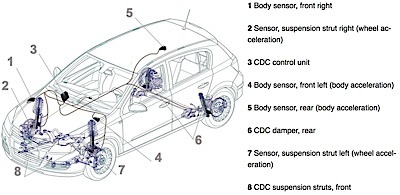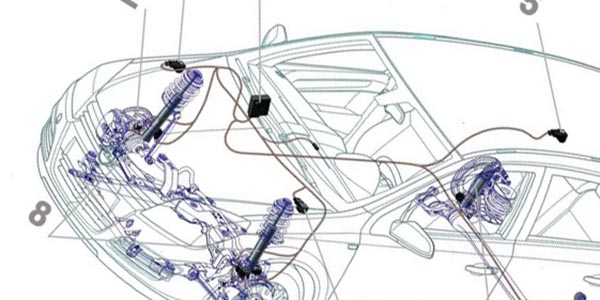
More automotive manufacturers today are opting for the use of the continuously variable damping system called Continuous Damping Control (CDC) in their vehicles. It permanently monitors “influencing” factors, such as the road condition, load, vehicle body acceleration and driver’s actions. The vehicle sensors register all of the changes. From this input, the control unit determines the optimal damping requirements. The proportional valve adapts the damping force in milliseconds for every wheel. This means better ride comfort and dynamics, less rolling and pitching motion and a shorter braking distance due to better road contact. These are advantages that are increasingly used in bus, coach, truck and agricultural machinery applications.
Self-Diagnosis
If there is an electrical or mechanical fault, the CDC damper must be checked just like a conventional damper and replaced if necessary. Even when you have to replace CDC dampers, no additional work on the electrics is required. In order to remove the CDC dampers, you only have to disconnect the plug from the wiring harness of the proportional damper valve and reconnect it during installation.
The CDC system is capable of performing a self-diagnosis, but it recognizes only electrical faults, not mechanical malfunctions. In the case of a fault, the CDC control lamp on the dashboard lights up. To narrow down the problem, a diagnosis unit is required, which can be used to read out and delete the error memory. Depending on the vehicle, it is also possible to compare the target/actual values in order to check the sensors of the CDC system.
Replacement in Pairs
CDC dampers must always be replaced in pairs. To guarantee full functionality, the add-on parts — impact stops, protection tubes and suspension strut mounts — must also be checked for wear before assembling the dampers. Every time the dampers are replaced, the service kit consisting of the protection tube and impact stop must also be exchanged.
Stressless Installation
Tension or strain on the dampers can be avoided by tightening the lower fastening screws only when the vehicle is standing on its wheels. After that, the wheel geometry is measured and readjusted, if necessary. After every CDC damper change that is carried out per axle, the system functions need to be checked. When the ignition is switched on, the CDC control lamp must go out after approximately 10 seconds. The CDC damper system will now be ready for use.














